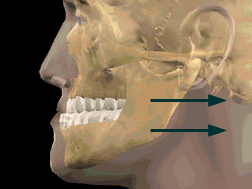Orthognathic Surgery
Orthognathic surgery is needed when jaws don't line up correctly and/or teeth don't seem to fit within the jaws. The word orthognathic originates from two other words; ortho (straight) and gnathous (jaw). Orthognathic surgery means "straight jaw surgery" and is used to correct jaw deformities. Just as orthodontics means straight teeth, and orthopedics means straight feet, orthognathic means straight jaw.
Teeth are straightened with orthodontics, and corrective jaw surgery repositions misaligned jaws. This not only improves facial appearance, but also ensures that teeth meet correctly and function properly.

Who Needs Orthognathic Surgery?
People who can benefit from orthognathic surgery include those with an improper bite or jaws that are positioned incorrectly. Jaw growth is a gradual process and, in some instances, the upper and lower jaws may grow at different rates. The result can be a host of problems that can affect chewing function, speech, breathing, long-term oral and facial health, and, last but certainly not least, appearance. Injury to the jaw and birth defects can also affect jaw alignment. While orthodontics alone can correct bite problems if only the teeth are involved, orthognathic surgery may be required if the jaws also need repositioning.
Difficulty in the following areas should be evaluated:
- difficulty in chewing, biting or swallowing
- speech problems
- chronic jaw or TMJ pain
- open bite
- breathing problems
- protruding (large) jaw
- recessive (small) jaw
Any of these can exist at birth or may be acquired after birth as a result of hereditary or environmental influences, or trauma to the face. Before any treatment begins, a consultation will be held to perform a complete examination with x-rays. During the pre-treatment consultation process, feel free to ask any questions that you have regarding your treatment. When you are fully informed about the aspects of your care, you and your dental team will make the decision to proceed with treatment together.
Technology and Orthognathic Surgery
Dr. Bates uses modern computer technology and three dimensional models to show you exactly how your surgery will be approached. Using comprehensive digital facial and oral photographs, digital X-rays and computer imaging, we can show you how your bite will be improved and even give you an idea of how you'll look after surgery. This helps you understand the surgical process and the extent of the treatment prescribed, and to see the benefits of orthognathic surgery.
If you are a candidate for corrective jaw surgery, Dr. Bates will work closely with your dentist and orthodontist during your treatment. The actual surgery can move your teeth and jaws into a new position that results in a more attractive, functional and healthy dental-facial relationship.
